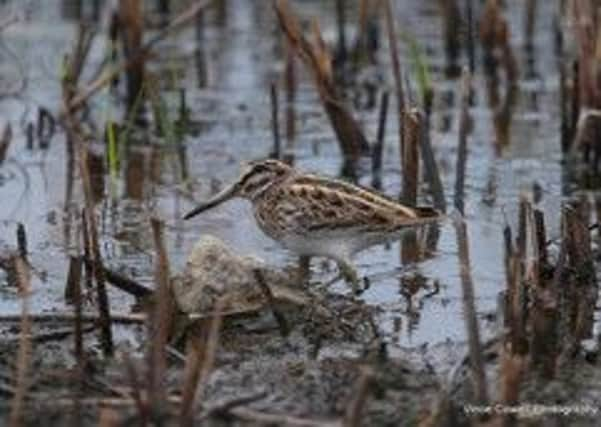Birdwatch: The Jack Snipe


In the past people were lucky to get more than a glimpse of one after it was flushed, flew a few yards, then dropped into cover again. But now there are more nature reserves with hides overlooking pools where jack and common snipe can be seen at the edges.
A few weeks ago I had good views of two jack snipe at close quarters from the Canal Scrape hide at Spurn.
Advertisement
Hide AdAdvertisement
Hide AdThe jack snipe is three inches shorter than the common and with a much shorter bill but unless the two are side by side this isn’t always apparent. The safest distinction between the two is the difference in head patterns. The jack has two yellow-buff stripes, one on each side of its head while the common has a third thin yellow stripe down the middle.
The jack snipe also has an odd habit while feeding. It bounces up and down while standing like a little clockwork toy before moving on and repeating the process.
It is a habit the jack snipe shares with the woodcock. It’s thought the bouncing causes vibrations in the mud to disturb small creatures, making them easier to find.
This is the time of year when birds can turn up from almost anywhere, proved by two rare warblers in the region, an eastern crowned warbler which should’ve been in the jungles of Bangladesh or Cambodia and a blackpoll warbler from the northern United States and Canada.
Advertisement
Hide AdAdvertisement
Hide AdThe eastern crowned warbler was found in a copse at the Hunley Hall golf course at Brotton near Redcar last week by local birder Ian Kendall.
Large numbers of birders managed to see it before it disappeared on Sunday – the first British record was further up the east coast at Trow Quarry, South Shields in October 2009.
As the crowned warbler disappeared attention switched to a field at Easington after well-known Yorkshire birder Mick Turton found a blackpoll warbler. This species migrates south to Puerto Rica and northern South America for winter and some of their journey is across the Atlantic so it’s likely this bird was swept here in the aftermath of Hurricane Bertha.
Rough-legged buzzards continue to be seen across the county with one still near the airfield at Grindale north of Bridlington, two on Broomhead Moor, South Yorkshire, three-plus on the North York Moors around Commondale, and singles at Hardcastle Crags, Buckstones Moss and Marsden, West Yorkshire.
Advertisement
Hide AdAdvertisement
Hide AdStrong northerly winds which began on Wednesday brought large numbers of little auks past Flamborough and Spurn also red-throated, black-throated and great northern divers.
A citrine wagtail and water pipit were at South Landing, Flamborough while two snow buntings have lingered around the fog station. Two snow buntings were seen inland at Soil Hill, Halifax and singles at Redmires reservoir and Strines, South Yorkshire and Swillington Ings, Leeds. There was a late sighting of a juvenile black tern at several places in South and East Yorkshire.